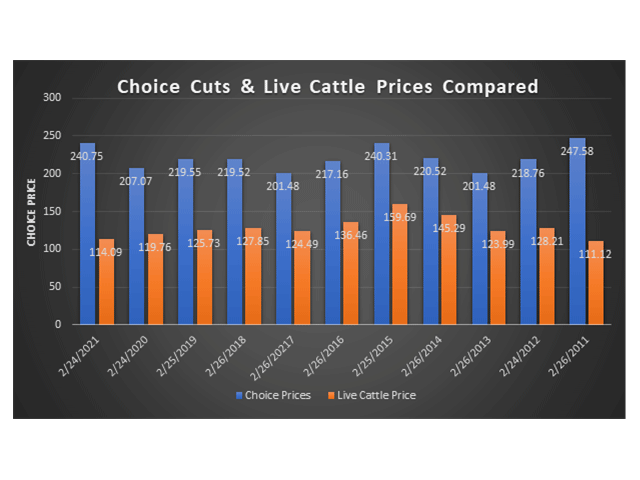Call the Market
Cattle Market Profits Need to Trickle Down to Feedlots and Cow-Calf Producers
Tensions about the cash cattle market are high, and rightfully so, as cattlemen are tired of scraping up the dismal leftovers that the market flings their way if the stars happen to magically align. Cattlemen are relentless and are never the first to complain or ask for sympathy, but upon stomaching last week's bitterly stark realities, feedlots have had enough.
This isn't about sympathy, it's about good business practice.
In case you missed it, last week boxed beef prices climbed to the second-highest price that they have ever been at for the last week of February, compared to other years during that week -- while cash prices hover at the lowest prices that they've been in during the last 10 years during the same time frame.
Looking at the chart associated with this column, you can see that the biggest spread between live cattle prices and choice cuts was back in 2011, but oddly -- exactly 10 years later -- we find the market in a similar situation as boxed beef prices are high but live cattle prices are near decade lows. In the last 10 years, live cattle prices have most comfortably traded for anywhere between $119.76 and $136.46 through the fourth week of February. The chart's outlying live cattle prices were $159.69 and $145.29 when prices were strong, and $111.12 and $114.09 when prices were low.
P[L1] D[0x0] M[300x250] OOP[F] ADUNIT[] T[]
Taking the market's strong boxed beef position out of the equation for just a second, last week's market still traded anywhere from $5.67 to $22.37 lower than the market's usual live cattle trend for the last week of February. Throwing boxed beef prices back into the equation, shouldn't higher boxed beef prices be incentive for a stronger cash cattle market? The answer is yes, it undoubtedly should -- no questions asked.
Looking at DTN's meat value per head formula, which takes into account live weight, daily choice/select prices, the drop value per head and the percent of carcasses that are grading choice/select at the time, gives one a better understanding of what live cattle are worth in a meat value perspective. On Feb. 24, the live cattle equivalent of gross packer revenue was $177.81.
Understanding what the $177.81 represents is vital because thinking that packers are going to pay $177.81 for cattle when boxed beef prices are as strong as they are is far from the truth and not realistic. The $177.81 represents the meat value per head on live cattle, not what packers should pay for live cattle. Something that we all painfully understand is that we all need to make a profit, packers included. Arguably one of the market's biggest flaws is that there are profits being made, but they don't trickle down throughout the supply chain.
Looking at the market's trends during the last 10 years, I tried to find some insight to share on the weeks and months to come. The hard thing about today's marketplace is that it has changed so much, and perhaps far faster than ever before. In just one year, the beef industry survived a global pandemic, packing plants being shut down and the food-service industry completely reconstructed compared to what it used to be.
Today the cattle market sits in a completely different scenario, as the nation continues to endure drought conditions and is in a different phase of the cattle cycle with herds liquidating and beef demand -- both internationally and domestically -- growing robustly.
The cattle market is alive and well, the problem is that the feeding sector, and cow-calf producers, aren't reaping the benefit of the market's strength.
ShayLe Stewart can be reached at ShayLe.Stewart@dtn.com
(c) Copyright 2021 DTN, LLC. All rights reserved.






